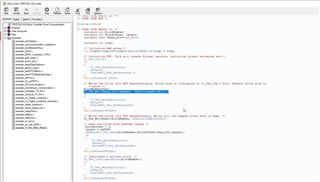Other Parts Discussed in Thread: HALCOGEN
Tool/software:
Hello,
I am working on FEE in order to store some data and calibration values in non-volatile memory.
The FEE Driver is enabled in HalCoGen version 04.07.01 in order to generate the driver, configuration and device specific files. The F021 Flash API library version 02.01.01 that is located in the HalCoGen install folder is also used in the project.
I have two questions regarding the FEE:
1) Is my setup correct or shall I add/replace some files?
I see in the online ressources that the TMS470M Flash EEPROM Emulation Driver can be downloaded. But it seems not to be supported by my device, and to be an older version that the one generated by HalCoGen.
I couldn't find a version for my device in the online ressources so I assume that I shall keep the files generated by HalCoGen, and not replace them by a library/driver found elsewhere.
2) After reading the TI FEE User Guide, I understand that it is not possible to store data in the 4 flash sectors simultaneously: only 2 of them can be used, while the other 2 will be used when the first ones will be full.
Is my understanding correct ?
Thank you for your support,
Dany






